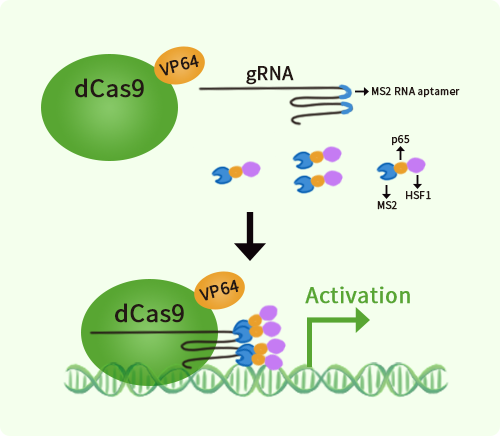Mouse Ppp5c activation kit by CRISPRa
CAT#: GA203365
Ppp5c CRISPRa kit - CRISPR gene activation of mouse protein phosphatase 5, catalytic subunit
Find the corresponding CRISPRi Inhibitor Kit
USD 1,657.00
2 Weeks*
Specifications
| Product Data | |
| Format | 3 gRNAs (5ug each), 1 scramble ctrl (10ug) and 1 enhancer vector (10ug) |
| Symbol | Ppp5c |
| Locus ID | 19060 |
| Kit Components | GA203365G1, Ppp5c gRNA vector 1 in pCas-Guide-GFP-CRISPRa GA203365G2, Ppp5c gRNA vector 2 in pCas-Guide-GFP-CRISPRa GA203365G3, Ppp5c gRNA vector 3 in pCas-Guide-GFP-CRISPRa 1 CRISPRa-Enhancer vector, SKU GE100056 1 CRISPRa scramble vector, SKU GE100077 |
| Disclaimer | These products are manufactured and supplied by OriGene under license from ERS. The kit is designed based on the best knowledge of CRISPRa SAM technology. The efficiency of the activation can be affected by many factors, including nucleosome occupancy status, chromatin structure and the gene expression level of the target, etc. |
| Reference Data | |
| RefSeq | NM_011155 |
| UniProt ID | Q60676 |
| Synonyms | AU020526; PP5 |
| Summary | Serine/threonine-protein phosphatase that dephosphorylates a myriad of proteins involved in different signaling pathways including the kinases CSNK1E, ASK1/MAP3K5, PRKDC and RAF1, the nuclear receptors NR3C1, PPARG, ESR1 and ESR2, SMAD proteins and TAU/MAPT. Implicated in wide ranging cellular processes, including apoptosis, differentiation, DNA damage response, cell survival, regulation of ion channels or circadian rhythms, in response to steroid and thyroid hormones, calcium, fatty acids, TGF-beta as well as oxidative and genotoxic stresses. Participates in the control of DNA damage response mechanisms such as checkpoint activation and DNA damage repair through, for instance, the regulation ATM/ATR-signaling and dephosphorylation of PRKDC and TP53BP1. Inhibits ASK1/MAP3K5-mediated apoptosis induced by oxidative stress. Plays a positive role in adipogenesis, mainly through the dephosphorylation and activation of PPARG transactivation function. Also dephosphorylates and inhibits the anti-adipogenic effect of NR3C1. Regulates the circadian rhythms, through the dephosphorylation and activation of CSNK1E. May modulate TGF-beta signaling pathway by the regulation of SMAD3 phosphorylation and protein expression levels. Dephosphorylates and may play a role in the regulation of TAU/MAPT. Through their dephosphorylation, may play a role in the regulation of ions channels such as KCNH2.[UniProtKB/Swiss-Prot Function] |
Documents
| Product Manuals |
| FAQs |
| SDS |
Resources
Other Versions
| SKU | Description | Size | Price |
|---|---|---|---|
| KN513791 | Ppp5c - KN2.0, Mouse gene knockout kit via CRISPR, non-homology mediated. |
USD 1,657.00 |
{0} Product Review(s)
Be the first one to submit a review






























































































































































































































































 Germany
Germany
 Japan
Japan
 United Kingdom
United Kingdom
 China
China
